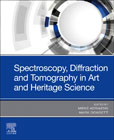
Spectroscopy, Diffraction and Tomography in Art and Heritage Science
Adriaens, Mieke
Dowsett, Mark
Spectroscopy, Diffraction and Tomography in Art and Heritage Science gives an overview on the main spectroscopy and diffraction techniques currently available for cultural heritage research. It starts with an introductory, general discussion of spectroscopy and diffraction and the kinds of information they can give. Further sections deal with, respectively, typical laboratory methods, mobile equipment, and large-scale instruments and infrastructural methods. The work concludes with comments on combining and comparing multiple techniques, sources of error, and limitations of the analytical methods. Explains spectroscopy and diffraction techniques in detail, yet remains accessible to those without a chemistry or physics backgroundProvides explanations of commonly used terms, such as destructive, non-destructive, non-invasive, in-situ, and ex-situ, and their sometimes-misleading originsIncludes real-world examples that demonstrate how each technique is used in the field Highlights the complementary use of different analytical techniques in fully interpreting the data INDICE: 1. Origins and Fundamentals 2. The multi-spectral analysis of scattered light for the detailed study and reconstruction of paintings 3. Raman and infrared spectroscopy in conservation and restoration 4. Terahertz spectroscopy in conservation 5. Spectroscopy and diffraction using the electron microscope 6. UV - visible - near IR spectrophotometry in a museum environment 7. X-Ray and Neutron Tomagraphies 8. X-ray diffraction 9. Mass spectrometric methods 10. Laser induced breakdown spectroscopy 11. Neutron Diffraction 12. X-ray spectroscopy in the laboratory and using synchrotron light 13. High energy particle analysis 14. Optical coherence tomography
- ISBN: 978-0-12-818860-6
- Editorial: Elsevier
- Encuadernacion: Rústica
- Páginas: 350
- Fecha Publicación: 01/06/2020
- Nº Volúmenes: 1
- Idioma: Inglés
